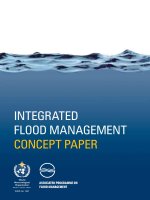Genesis flood
Bạn đang xem bản rút gọn của tài liệu. Xem và tải ngay bản đầy đủ của tài liệu tại đây (981.48 KB, 32 trang )
The Genesis Flood
in
Pre-Darwinian American
Geology
The Case of Edward
Hitchcock
Rodney L. Stiling
Department of History
Seattle Pacific University
206/281-2680
19C American Geology
• Qualitative
Quantitative
• Proto-mathematical
Mathematical
• Pre-petroleum
Petroleum
• Pre-Darwinian
Darwinian
Edward Hitchcock
1793-1864
•
•
•
•
•
•
Pastor
Teacher
Professor of Geology & Chemistry
College President
Author
Professional Geologist
– State Surveys
– AGS / AAGN / AAAS
Hitchcock and Geology
• Student of Benjamin Silliman at Yale
• Professor of Geology and Chemistry at
Amherst College from 1825
• Head of Massachusetts State Geological
Survey (1831 – 1841)
• First President of Association of American
Geologists and Naturalists (1841)
• Founding Member of AAAS
The Flood: Four Interpretations
•
•
•
•
Revolution Model (Cuvier)
Diluvial Model (Buckland)
Transient / Blended Model (Buckland)
Local / Regional Model (Smith)
Four Floods Overview
Thomas Cole (1801-1848)
“The Subsiding Waters of the Deluge” (1829)
Continental-Seabed
Revolution Model (~1820)
Drawn from Georges Cuvier (1812)–
“the catastrophes . . . caused the different
parts of our continents to rise by degrees
from the basin of the sea, but it has also
frequently happened, that lands which had
been laid dry have been again covered by
the water
. . . .
if there is any circumstance thoroughly
established in geology, it is, that the crust
of our globe has been subjected to a great
and sudden revolution, the epoch of which
cannot be dated much farther back than
Revolution Model
Revolution Model (~1820)continued
Hitchcock:
“the crust of our globe has
undergone several revolutions by
the overflowing of water – and
secondly that the last revolution of
this kind was not very remote”
“Our present continents were in
the bottom of the ocean in the
antediluvian day and the
continents that then existed are
now in the same situation – that is
when the first were submerged the
last emerged”
Four Floods Overview
Diluvial Model (1823)
William Buckland (1784-1856)
Reliquiae Diluvianae (1823)
“. . .undeniable evidence of a recent transient
inundation . . . . justified in applying the
epithet diluvial to the results of this great
convulsion. . .”
Hitchcock: Diluvium = Flood evidence
Geology is “found more and more to speak
the language of Revelation”
Diluvial Model
Four Floods Overview
Blended / Transient Model (1838)
• Hitchcock: “deluge” and “powerful rush of water”
have indeed swept North America, but, “is it, or is
it not identical with that described by Moses?”
• Problem: Human remains never found in diluvial
formations (Buckland, 1836)
• Therefore diluvium anterior to humankind
• Deluges frequent but brief; Noah’s Flood evidence
either blended or overgrown: “no traces be now
remaining on the earth’s surface of that event.”
Four Floods Overview
Local/Regional/Partial Model
(1841)
• Influence of John Pye Smith (1774-1851)
• On the Relation Between the Holy Scriptures
and Some Parts of Geological Science
(1839)
• Hitchcock – Flood: “universal terms with
limited meaning” and “not universal over the
globe, but only over the region inhabited by
man.”
• Central Asia – no geological traces
Local/Regional/Partial Flood
Local/Regional/Partial Flood
Hitchcock’s Summary
“ on no subject has there been a greater
change of opinion. From a belief in the
complete destruction and dissolution of the
globe by that event, those best qualified to
judge now doubt whether it be possible to
identify one mark of that event in nature.”
The Religion of Geology (1851)









